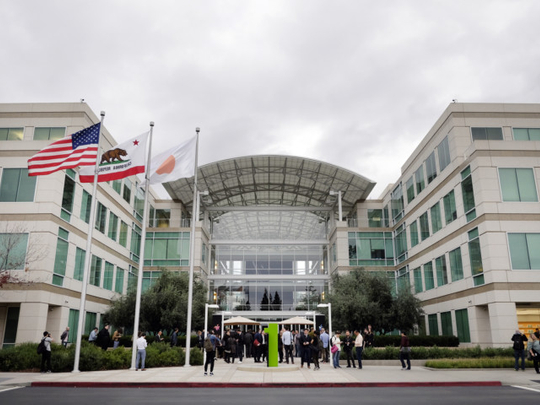
Towards the end of a talk late last month at the Hirshhorn Museum in Washington, Apple’s chief design officer, Jonathan Ive, vented for a moment about the backlash against Apple Park, the company’s 2.8-million-square-foot circular headquarters building that has drawn some scorn for a perfectionist construction process that reportedly pushed its cost to $5 billion (Dh18.39 billion).
“We didn’t make Apple Park for other people,” Ive said after his onstage interviewer.
On the day of Ive’s appearance in Washington, his employer rushed out a patch for macOS High Sierra to fix a bug that allowed unrestricted, password-free access to that operating system — a level of vulnerability that Mac users righteously mocked in Windows almost 15 years ago.
The next day, Apple shipped a bug-fix fix: A supplemental patch to restore file-sharing functions that some users had seen broken by the initial update.
Last week, Apple had to hurry another software repair release, this time for a glitch in its iOS 11 mobile software that as of December 2 began sending iPhones and iPads into a loop of crashes if they ran an app that pushed certain notifications to the screen.
That problem had apparently gone unfixed in the iOS update shipped three weeks earlier to stop the on-screen keyboard from turning the letter “I” into a “A” followed by a question mark in a box, but which itself left a different auto-correct glitch that turned “it” into “I.T” unfixed until Saturday’s patch.
Even Apple’s hardware, traditionally a point of justifiable pride for the Cupertino, California, company, hasn’t been looking as reliable lately. Users of its new, $1,299-and-up MacBook Pro laptops have complained about battery life well short of Apple’s estimates and “butterfly switch” keys that, as Casey Johnston recounted in an October post at the Outline, can fail if dust gets lodged under one — after which the only recourse may be replacing the entire top case of the laptop body.
These aren’t edge-case software breakdowns or random manufacturing glitches. They’re the kind of reproducible flaws that companies are supposed to find and fix before shipping a product.
The most valuable publicly traded company in America, with a market capitalisation nearing $1 trillion, has also found itself incapable of keeping its computer line-up current.
The affordable, but still versatile MacBook Air hasn’t seen a major update since 2015 and now looks abandoned. After neglecting the high-end Mac Pro desktop for even longer, Apple had to break its long-standing rule against commenting on unannounced products this spring to promise a completely redesigned version ... after this year. And the Mac mini that once represented a bold move to lure PC users is now more than three years stale.
The attention lavished on Apple Park, meanwhile, shows far more rigorous attention to detail. A February report by Julia Love of Reuters recounted such pursuits of perfection as 30 or so pages of documentation for woodwork, Apple’s insistence that doorways be perfectly flat so that engineers need not adjust their gait to avoid a threshold, and “a year-and-a-half of debate” over a door handle’s contours.
A Wired cover story by Steven Levy this summer offered further testimony to Apple’s dedication to detail: The 440,000-pound (199,580kg), four-storey glass doors that let the outside into the cafeteria, concrete beams in a parking deck that conceal plumbing and wiring instead of subjecting employees to the sight of suspended pipes, and a patented pizza container with vents that let out moisture to keep a slice’s crust crisp longer.
Apple PR did not respond to a request for comment emailed last Saturday, in keeping with its long-standing habit of opacity. But a personnel move revealed last Friday suggested one high-ranking Apple executive had been distracted by Apple Park’s construction: Ive, who Bloomberg’s Mark Gurman and Alex Webb reported had returned to directly managing Apple’s design efforts after two years. Apple Park certainly sounds like a pleasant place to work, if not to have worked on. Journalists who have visited it — I haven’t — have said as much.
But if the company wanted to craft a target for resentment among its loyal customers, it could not have done much better than to put this circle of glass and metal on the map.
At his talk in Washington, Ive made a case that by putting designers across multiple disciplines in the same space, Apple Park will yield better products down the line. (Possibly years down the line: The Apple Watch, designed with zero input from Steve Jobs, shipped almost three years after Jobs’s death in October 2011.)
“I can’t imagine another time in the future where we get to try and make something that is for us,” he said. “Not to be indulgent in a sort of ghastly, selfish way; we made it for us, to try to help us do better.”
But the Apple customers of today can’t caress Apple Park’s wood panelling, stride uninterrupted through its threshold-free doorways or treat themselves to a non-soggy pizza at one of its desks courtesy of that patented pizza box.
The closest most can get is to visit one of Apple’s stores. Since the first one opened in suburban Washington more than 16 years ago, they’ve been both marvels of design and a pleasant place to try to buy Apple’s work. They also remain a good place to get help when its software and hardware don’t testify to its ability to get the details right — which seems to happen a lot these days.
— Washington Post
Rob Pegoraro covers technology for Yahoo Finance, USA Today, the Wirecutter and other sites. From 1999 to 2011, he wrote the Washington Post’s personal-tech column.









